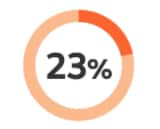Great news: Thanks to advancements in medicine and health technology, the average life expectancy for Canadians has increased – it’s now roughly 80 years for men and 84 for women.1
There is, however, a potential downside to a longer life expectancy. With Canadians living longer and spending more years in retirement, their savings must now be able to adequately fund a retirement that could last two decades or more.

What is longevity risk?
Longevity risk is one of the main concerns facing retirees. It refers to the risk of outliving your savings. It can occur for a number of reasons – you might underestimate how much money you’ll need in retirement; your savings might not grow enough over time to fund your desired retirement; or you may live longer than anticipated.
How you can minimize longevity risk
Longevity issues generally arise as people enter retirement, with a fixed amount of money, but no clear idea of how much is actually needed to fund their desired retirement – for potentially more than two decades. Ultimately, everyone’s retirement savings needs will be different as much will depend on individual spending habits, expenses and lifestyle goals.
A good way to help ensure you’ll have enough money throughout your retirement is to thoroughly plan. Your planning can start by taking these three items into consideration:
- All your income sources in retirement, such as government and/or workplace pensions, registered and non-registered accounts, and Tax-Free Savings Accounts (TFSAs)
- Your current expenses and estimated future expenses, to help estimate how much you may spend in retirement, while also identifying debt or expenses that can be reduced or eliminated before you retire
- Estimated future health care costs, factoring in government and/or employer benefits that you’ll have access to in retirement, and also taking into account any chronic health conditions you suffer from, such as diabetes or hypertension
A Scotiabank advisor can provide you with retirement planning advice and help you build a financial plan that will set you on the path to building the retirement you’ve envisioned. It all starts with a simple conversation:
Book an appointment with a Scotiabank advisor today or visit scotiabank.com/retirement for timely financial articles, tips and tools, like the Retirement Savings Calculator.
Managing longevity risk with your long-term savings
Typically, when investors think about risk, they focus more on the day-to-day fluctuations in the markets and place emphasis on recent activity. In other words, investors tend to give more importance to short-term, rather than long-term performance. Behavioural finance experts call this recency bias.
The downside of letting actual or perceived market risk impact long-term planning, specifically retirement planning, is very real. An overly conservative approach to retirement investing can limit your growth potential, and with that, increase the risk of falling short of your retirement goals or running out of money – especially after factoring in inflation.

How can you manage longevity risk?
Diversifying your portfolio to include a balance of conservative and growth-oriented investments has the potential to boost the value of your portfolio over the long run and combat longevity risk.
Keep in mind that any move to increase the return potential of your portfolio comes with added risk, but that risk can be managed with proper planning and the right balance of investments for each stage of your life.
While building an adequate retirement portfolio is job one, a retirement income plan can help create sustainable cash flow throughout your retirement years when your regular paycheque stops. Your retirement income plan and withdrawal rate should take all your retirement resources into account, including government benefits, employer pension plans and your personal savings, including registered investments.
Speak with a Scotiabank advisor to ensure you have a personalized plan and an appropriate mix of investments that can help you to achieve, and maintain, your desired retirement lifestyle.
Closing the funding gap in retirement
Following are some strategies to consider if you think you may encounter a gap between your retirement savings and your desired retirement lifestyle.
1. Increase your current rate of savings
If you have set up regular contributions to go towards your retirement savings through Pre-Authorized Contributions (PACs), consider increasing your contribution amount and/or frequency (e.g., change monthly contributions to bi-weekly). If you don’t have a PAC in place, consider setting one up as it’s a great way to build your savings easily and automatically. To see how quickly your savings can grow, visit scotiabank.com/PAC and try out our interactive PAC video.
2. Retire at a later date
Continuing to work for a few more years may provide you with the funds needed to help you achieve and/or extend the retirement lifestyle you want.
Quick Facts
Here's when Canadians say they expect to retire from the workforce

23%- Between 65 and 69

19% - Between 60 and 64

10% - Between 55 and 59
Source: Scotiabank, Scotiabank Investment Poll, 2021.
3. Change certain lifestyle assumptions
If you’re worried about longevity risk, you could consider making some changes to your retirement lifestyle. Maybe that means decreasing the number or length of trips you take each year, or perhaps downsizing to a smaller residence to reduce your household expenses (e.g., utilities, property tax, insurance).
4. Explore part-time work options in retirement
Another strategy for extending your retirement savings might be to take on part-time work. Depending on your specific career, you may be able to continue to work part-time or consult in the same field from which you retired. This income may allow you to draw a smaller amount from your retirement savings, thereby extending the amount of time your savings will last.
5. Consider leveraging your home’s value
The value of your home has likely increased significantly over the years, which means you could look into a borrowing plan tied to the equity in your home. To learn more about this option and to see if it’s the right strategy for your situation, you can speak with a Scotiabank advisor.
Another option may be to consider renting out your basement (if it’s finished) to supplement your income, or to rent out your home during the winter months if you escape to a warm destination each year. This is also a good way to ensure you’re not leaving your house empty for an extended period of time.
How long will $100,000 last?
Let’s take a look at three scenarios of someone who retires with a $100,000 investment and see how much they can withdraw each month based on a retirement that spans 10, 20 or 30 years. This example assumes the investment will be fully depleted over 10, 20 or 30 years.
Monthly withdrawal amount for retirement spanning 10, 20 or 30 years

As the graph illustrates, the longer the time in retirement, the less money a retiree will be able to withdraw every month as the savings need to be stretched out over a longer period of time.*


